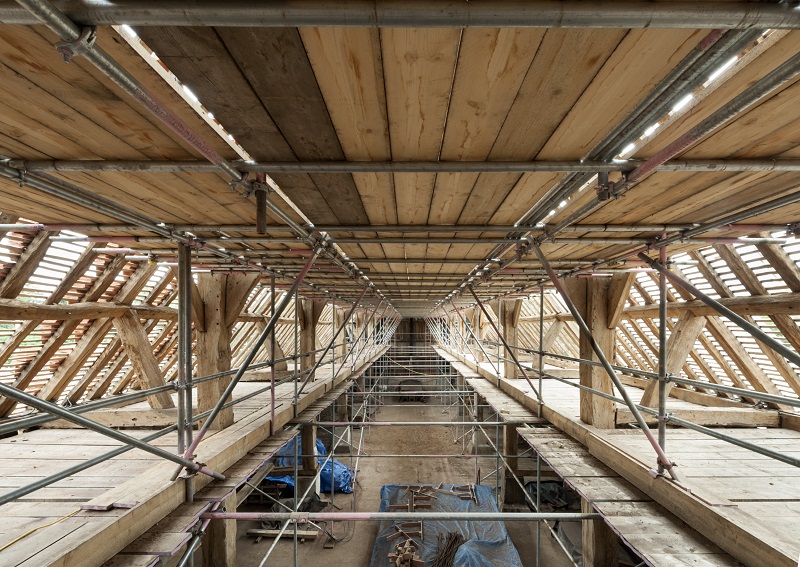A Comprehensive Overview to the Necessary Functions of Scaffolding in Modern Building And Construction
The landscape of modern building and construction significantly relies upon efficient scaffolding systems that prioritize performance, safety and security, and development. As projects grow in intricacy, comprehending the crucial attributes of scaffolding ends up being critical for guaranteeing worker security and enhancing project timelines. This overview discovers different kinds of scaffolding, highlights vital safety and security attributes, and takes a look at material advancements that add to efficiency and sustainability. The implications of these elements extend much beyond mere building techniques, prompting a more detailed look at exactly how they influence general task success and worker wellness.
Kinds Of Scaffolding
Although scaffolding systems can differ extensively in design and application, they usually come under a number of distinct groups that accommodate various building and construction demands - Scaffolding. One of the most usual kinds include sustained scaffolding, put on hold scaffolding, and rolling scaffolding
Supported scaffolding contains platforms sustained by a structure of poles, which offer a stable and elevated working surface. This kind is generally made use of for jobs that need considerable altitude, such as bricklaying or outside paint.
Put on hold scaffolding, on the other hand, is utilized for jobs needing access to high altitudes, such as cleaning or fixing structure facades. This system hangs from a rooftop or an additional framework, allowing workers to lower or elevate the system as needed.
Rolling scaffolding attributes wheels that permit very easy wheelchair throughout a task website. It is specifically beneficial for jobs that require constant moving, such as indoor job in large areas.
Each kind of scaffolding is made with particular applications in mind, ensuring that building and construction tasks can be executed effectively and properly. Comprehending these groups is crucial for selecting the ideal scaffolding system to fulfill both task requirements and site problems.
Trick Safety Attributes
Security is critical in scaffolding systems, as the potential risks associated with working at heights can result in major mishaps if not appropriately taken care of. Trick safety and security features are vital to ensure the well-being of employees and the stability of the building website.
First and foremost, guardrails are critical. These obstacles give a physical secure against drops, dramatically reducing the threat of major injuries. In addition, toe boards are often utilized to avoid tools and materials from diminishing the scaffold, safeguarding workers below.
An additional crucial element is making use of non-slip surfaces on systems. This function boosts hold, especially in negative weather condition problems, thereby decreasing the probability of slips and falls. Accessibility ladders should be firmly placed to assist in safe entry and exit from the scaffold.
Regular examinations and maintenance of scaffolding systems are additionally crucial. These examinations make sure that all components are in good condition and functioning appropriately, dealing with any type of wear or damages promptly.
Lastly, proper training for all employees associated with scaffolding operations is important to make certain that they comprehend security methods and can recognize potential hazards. Scaffolding. Jointly, these attributes create a more secure working atmosphere and significantly alleviate risks connected with scaffolding
Product Technologies
Advancements in product science have actually dramatically affected the scaffolding market, improving both safety and efficiency in contemporary construction. The intro of high-strength steel and light weight aluminum alloys has actually revolutionized typical scaffolding systems. These materials are not only lighter, making them simpler to set up and transport, but likewise offer premium load-bearing abilities. This results in scaffolding frameworks that can sustain greater weights while lessening the threat of collapse.
In addition, ingenious composite products, such as fiberglass-reinforced plastics, have actually become viable options. These products are resistant to deterioration and ecological deterioration, thus extending the life-span of scaffolding systems, especially in extreme climate condition. Making use of such materials adds to lower maintenance costs and guarantees constant efficiency in time.


Design Factors To Consider
Thinking about the intricacies of contemporary construction jobs, effective scaffolding layout is critical to making certain both performance and safety and security. Style considerations need to incorporate various aspects, consisting of lots capacity, height, and the details requirements of the building and construction website. Each project offers unique difficulties, demanding an adaptable strategy to scaffolding systems that can adapt to varying problems.
Architectural integrity is important; consequently, engineers need to compute the loads that the scaffolding will sustain, consisting of workers, products, and tools. The selection of products plays an important duty in ensuring the scaffolding can endure these tons while continuing to be light-weight and sturdy. Additionally, the design should permit very easy accessibility and egress, facilitating the smooth movement of products and workers.
Safety and security attributes, such as guardrails and non-slip surface areas, should be incorporated to reduce risks of accidents. Additionally, the design needs to take into consideration the surrounding setting, consisting of nearby structures and prospective dangers. By attending to these layout considerations, building and construction companies can improve the efficiency of scaffolding systems and promote a more secure working environment, inevitably adding to the overall success of the project.
Maintenance and Evaluations
The effectiveness of scaffolding systems expands beyond first layout and application; ongoing upkeep and routine evaluations are important to guaranteeing their proceeded performance and safety and security throughout the duration of a job. Normal examinations must be carried out by qualified employees to identify any kind of indications of wear, damage, or instability that could jeopardize the integrity of the scaffolding.
Upkeep protocols must consist of regular checks of structural components, such as slabs, frames, and installations, guaranteeing that all elements stay safe and totally free from deterioration or other damage. Additionally, the capability of security attributes, such as guardrails and toe boards, must be examined to make certain conformity with security laws.
Documentation of all evaluations and upkeep tasks is important for accountability and regulatory compliance. An organized strategy to record-keeping not only aids in tracking the problem scaffolder meaning in punjabi of the scaffolding but also supplies necessary proof in case of an event.
Eventually, developing a thorough upkeep and inspection routine will substantially lower the threat of crashes and boost the overall safety and security of the construction site. By prioritizing these techniques, construction supervisors can guard employees and promote the task's honesty.

Conclusion
To conclude, the necessary functions of scaffolding in modern-day building and construction include a range of vital elements, including diverse types, key safety and security systems, material technologies, and thoughtful style factors to consider. Highlighting safety via guardrails and non-slip surfaces, along with developments in products like high-strength steel, enhances both efficiency and sustainability. Additionally, normal maintenance and assessments are vital for making sure structural stability and safety on building websites, ultimately helping with reliable project implementation and advertising the well-being of workers.
The landscape of contemporary building significantly counts Visit Website on effective scaffolding systems that prioritize technology, safety, and efficiency.Improvements in product science have considerably affected the scaffolding sector, boosting both safety and security and performance in modern-day building and construction. On the whole, these material technologies not just improve the performance and safety of scaffolding systems but likewise straighten with the market's push towards sustainability, as several modern-day products are made to be a lot more ecologically friendly.
Considering the intricacies of modern-day building and click this link construction jobs, effective scaffolding layout is extremely important to making sure both performance and security.In conclusion, the essential attributes of scaffolding in contemporary construction incorporate an array of critical aspects, including varied types, vital security mechanisms, product developments, and thoughtful style considerations.